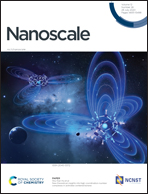New theoretical insights into high-coordination-number complexes in actinides-centered borane†
Abstract
The coordination number of a given element affects its behavior, and consequently, there is great interest in understanding the related chemistry, which could greatly promote the extension and development of new materials, but remains challenging. Herein, we report a new record high coordination number (CN) for actinides established in the cage-like An(BH)24 (An = Th to Cm) via using relativistic quantum chemistry methods. Analysis of U(BH)n (n = 1 to 24) confirmed these series of systems as being geometric minima, with the BH acting as a ligand located in the first shell around the uranium. In contrast, global searches revealed a low CN half-cage structure for UB24, which could be extended to the series of AnB24 materials and which prevails over the competing structural isomers, such as cages. The intrinsic geometric difference for AnB24 and An(BH)24 mainly arise from the B sp3 hybridization in borane inducing strong interactions between An 5f6d7s hybrid orbitals and B 2pz orbitals in An(BH)24 compared to that of AnB24. This fundamental trend presents a valuable insight for future experimental endeavors searching for isolable complexes with high-coordination actinide and provides details of a new structural motif of boron clusters and nanostructures.



 Please wait while we load your content...
Please wait while we load your content...